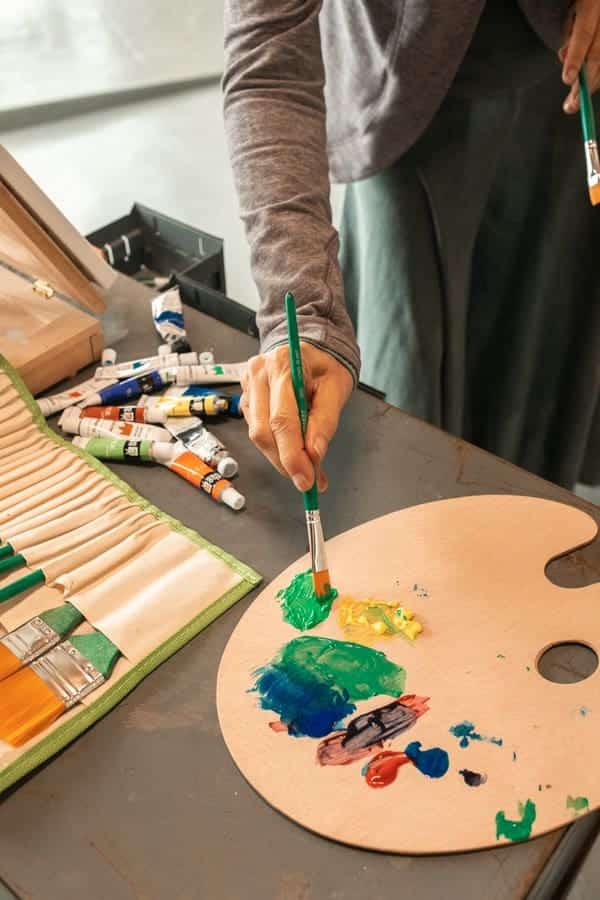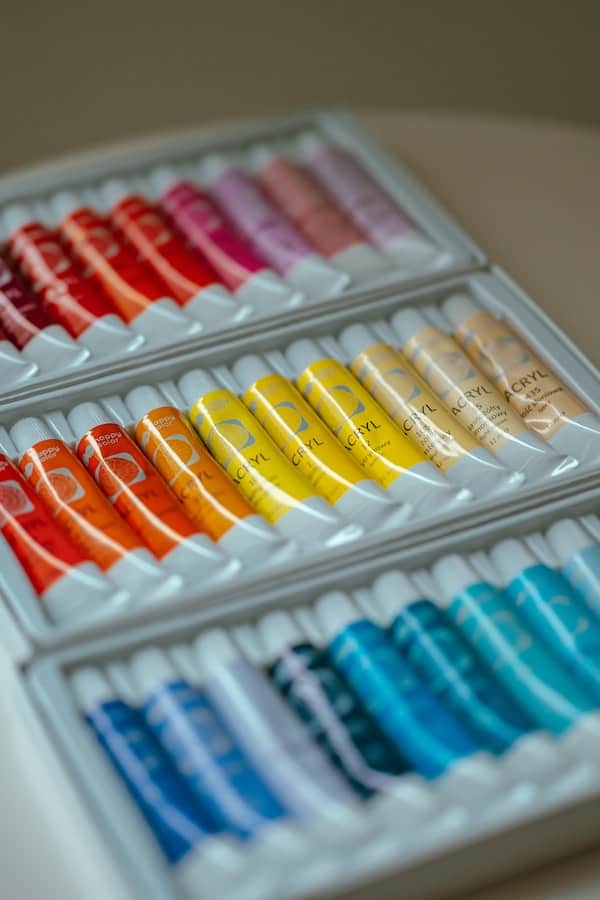If you are in the middle of renovating your home or a piece of furniture and you notice that you have spilled acrylic paint try not to panic. While it may be difficult to remove acrylic paint from some surfaces it is possible and we are here to show you how.
If you act quickly, before any paint drys, it is possible to quickly rid your wooden surfaces of paint but as this type of paint dries quickly you may need to explore our top paint stripping tips. If you are up-cycling an item of furniture that has been painted in acrylic and you want to remove it there is also advice on how you can remove the paint from the wood.
There may be affiliate links in this article. You can read more about this in my disclosure.
Acrylic Paints

Acrylic paint is a popular way to decorate wood and is made of three key ingredients; water, pigment, and acrylic resin. The benefits of acrylic paint are that they give bold color, and a pleasing finish and then dries quickly compared to watercolors.
An acrylic emulsion is present in water-based acrylic paint to bind pigment. As the acrylic does not dissolve in water it is an emulsion rather than a solution.
As the water evaporates from the acrylic paint and it begins to dry it is no longer water-soluble. This means that if acrylic paint has dried onto a surface, including wood, it will need to be cleaned with a solution that can dissolve the acrylic resin.
In some circumstances, you may be able to use a solution that will reduce the adhesion so that the paint can come away from the porous or non-porous surface. We will take a look at the best solutions to use to remove acrylic paint from wood and how they should be used.
What Happens When Acrylic Paint Goes on Wood?
When acrylic paint is applied to wood the three ingredients of the paint sit on top of it. The water will eventually evaporate and the stain and pigment are left behind.
As the remaining two ingredients are left to sit on the wood they fuse on the surface and interact with the air to cause a chemical reaction.

What Are the Types of Acrylic Paint?
Acrylic paint comes in the numbest of finishes; matte, gloss, and satin. Acrylic stain comes in matte only a variety of and will need varnishing if you want a gloss finish.
If you use acrylic paint will not soak into the surface like a stain would so it will be easier to remove acrylic paint than it is to remove a stain. The reason being is that the paint will sit on top of the surface rather than penetrating deep into the wood.
Remove Acrylic Paint from Wood
Acrylic paint is used by many artists or home renovators as it drys quickly and has a durable finish. For these reasons, it can be tricky to remove any spills quickly and effectively but is possible with a little hard work.
The best 6 Ways to Remove Acrylic Paint from Wood

1. Soapy Water
Top of the pile when it comes to cleaning acrylic paint from wood is good old soap and water. If the paint has only just spilled and is still fresh then you need to get to work on removing it with soap and water.
This method is good for removing from untreated wood but also varnished wood. You should use enough soap to create a lather so that it can penetrate the grain of the wood.
If the paint has started to dry this method is unlikely to be effective,
Steps
- Mix soap and water to create a lather.
- Soak a clean towel in the soapy mixture
- Use the towel to carefully rub the paint from the surface in a circling motion
- Rub until the paint has gone. You may need a second towel if there is a lot of pain to remove
- Use a dry towel to wipe the surface, removing any paint resides and any water
2. Rubbing Alcohol
Isopropyl alcohol, commonly known as Rubbing Alcohol is effective in removing dried acrylic from wood as it has a solvent action on the acrylic binder.
This method does require a lot of effort but it is cheap and readily available in drug stores and supermarkets. Rubbing alcohol has some solvent action on the acrylic binder.
Steps
- Pour the alcohol into a bowl
- Soak a towel in the bowl
- Blot the stain moving from the outside in. Be careful not to rub too harshly as it will push the stain into the wood
- Wash the wood with soap and water to get rid of any residue
3. Denatured Alcohol
Denatured alcohol is stronger than rubbing alcohol but it’s still safe to use on wood. It is stronger as it does not contain water and is made up of methyl and ethyl alcohol which may work on stubborn acrylic paint stains.
Steps
- Pour the alcohol into a bowl
- Soak a towel in the bowl
- Blot the stain moving from the outside in. Be careful not to rub too harshly as it will push the stain into the wood
- Wash the wood with soap and water to get rid of any residue
You should take care when using this alcohol as it is highly flammable. You will also want to wear protective equipment such as masks and goggles.
[amazon box=”B0787BS4HD” template=”vertical”]4. Ammonia
Applying ammonia to the stained area can help remove difficult spots of stubborn acrylic paint stains from wood. Ammonia can help stabilize acrylic emulsions by raising the pH levels.
You should take care to use gloves and a face mask/goggles to protect your hands and face as ammonia is a very strong liquid and may cause irritation or an allergic reaction.
Steps
- Pour a small amount of ammonia into a bowl of water
- Use a clean towel to dab a little of the solution from the bowl
- Starting from the outside of the stain run the bottom pad inwards to remove the stain
- Continue to rub the paint stain until it comes out. You will most likely need multiple towels if there is a lot of paint
- Wash the item of clothing as usual with detergent
5. Sanding
If the acrylic paint you want to get off the wood is very thick and one of the above liquid solutions is not working, you may need to try sanding the wood. This process will need a lot of work but it is effective.
Usually, this option to remove paint will be if you are up-cycling old furniture or the paint has been on the wood for a long time. You will need a power sander that you can buy or hire from a tool company.
If you cannot get access to a power sander you can use sandpaper or a sanding block that is effective but will take longer to get all of the paint off the wood.
Steps
- Make sure you are in a well-ventilated area and are wearing safety equipment including a set of goggles and a mask.
- Prepare your sanding machine or block and begin to use it in a back-and-forth motion to sand away the acrylic paint.
- Remove the dust with a brush or clean, dry towel
- Move to a higher grit sander and repeat the previous step to remove the acrylic closer to the wood.
- Clean up the remaining dust and then use a wet towel to wipe down the wood
6. Heat Gun
Heat guns are a great way to cut out dried acrylic paint from a large section of wood. Heat guns reach high temperatures so you do need to take very good care of yourself and the item you are using it on.
You should always follow the instructions on the heat gun leaflet and use protective equipment.
Steps
- Wear a protective mask and googles as well as gloves (leather is a good option) to protect yourself
- Turn the gun to its maximum setting
- Hold the heat gun around four inches above the surface, moving it in small, circular movements across the acrylic on the wood.
- You will see the paint bubble on the wood and when this happens carefully set down the gun and begin to scrape away the paint.
- Allow the wood to cool
- When the wood has cooled you should clean using soap and water using the steps taken early in this article
- Leave the surface to dry
Conclusion
If you are needing to get acrylic paint off wood, whether it be because you have spilled paint while renovating or you are wanting to change the look of a piece of furniture, there are a few options you can take.
You can use a variety of liquids, ranging from ammonia to alcohol or you can use a traditional sanding method. There is also the option to use a heat gun as this can help you scrape large areas of paint off wood.
No matter which method you use you can ensure you stay safe by using protective equipment such as masks and goggles. If you cannot remove the acrylic paint by any of these methods you may need to contact a professional cleaner.



